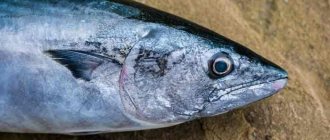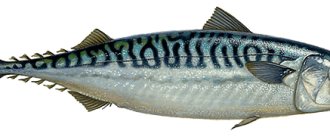Where did the confusion in definitions come from?
The confusion arose due to the fact that in the English language, from which the names of the fish tuna, mackerel and mackerel came to us, the meaning and connection of words in a sentence are conveyed not by changing the endings of words, but by a fixed sentence structure.
Thus, taken out of context, the English word "Mackerel" can mean either the name of the entire mackerel family, including mackerel, mackerel, tuna and bonito, or any of the three genera of king mackerel. Because of this inaccuracy in definitions and the external similarity of mackerel and mackerel, it is quite possible to buy another instead of one fish, so you should be careful when choosing.
Description
A representative of the mackerel family and the order Mackerelidae. It is a type of epipelagic fish that prefers reefs and waters near rocks in depth. It has a spindle-shaped body with thin scales. There is no swim bladder.
Predator, long-lived. Can live up to 18 years, unless it becomes prey for birds or people. Loves warm water. Lives in seas and oceans heated above 8 degrees. It mostly swims close to the coast, but in winter it goes deeper.
Description of appearance (you can see what it looks like from the photo):
- bluish or greenish back (sometimes blue);
- the abdomen is silver-gray or yellow;
- a row of small sharp teeth;
- black transverse stripes;
- length: 60-70 cm (can reach 240 cm).
There are 9 species of mackerel. They differ from each other not only in color. The Japanese variety reaches 1 meter in length, while the others, with rare exceptions, grow only up to 60 cm. The royal one has white meat, while the other mackerels have grayish meat. Less often gray-brown.
How to distinguish mackerel from mackerel
To understand the difference between mackerel and mackerel, it is enough to compare their sizes. Typically mackerel are larger than mackerel. In addition, it has a sharper snout shape and spotted body coloration. Mackerel has no spots on the carcass, only stripes, and they cover only the dorsal part of the carcass and do not fall below the midline of the fish. If the fish is sold as fillets, then it is not possible to assess the size of the carcass and the color of the skin. In this case, you need to evaluate the color of the meat fillet. In mackerel it is pinkish and even red, while in mackerel it is gray. Mackerel meat tastes fattier and juicier and contains more vitamins. Mackerel meat contains more protein and macronutrients, but it tastes drier and less juicy.
Use in cooking
Mackerel is one of the most valuable fish species in the food industry. It is moderately fatty, tasty, and after heat treatment the meat becomes light and dense.
The variety of dishes with mackerel is off the charts. They eat it:
- raw, flavored with citric acid and seasonings;
- fried;
- boiled;
- baked;
- boiled;
- smoked;
- salty;
- canned.
Fish is best suited for salads. But mackerel fish is better suited for baking and marinating.
Popularity of mackerel in different countries
Residents of central Europe prefer mackerel among all types of mackerel fish. The British fry it, the French bake it, and regardless of nationality, Europeans love this smoked fish. Russians prefer mackerel. It is eaten baked, boiled, salted and smoked. In America, the best-selling canned food is canned tuna. Here it is called the chicken of the sea. The Japanese are equally willing to eat mackerel, mackerel and tuna, adding them raw to sushi, sashimi and rolls.
Commercial and recreational fishing
Fish is a very valuable and nutritious food product . Therefore, commercial mackerel fishing continues to be a relevant and necessary activity.
In the Russian Federation, fishing takes place in the southern part of the Norwegian Sea. In a year it is possible to catch about 50 thousand tons of this valuable fish. Fishing takes place using special nets and seines. In the past, mackerel was also found in the Black Sea, but, unfortunately, disappeared about 35 years ago.
The mackerel's habitat is coastal waters, so there is no need to swim to the open ocean to catch fish. It can easily be caught with a fishing rod and spinning rod directly from the shore or a small boat.
You can fish from early spring until the coldest weather. For those who like fishing from the shore, the most favorable period will be the spring. Hungry fish swim closest to the shore, where more food can be found. No special gear is required for mackerel; a regular float rod is sufficient.
You can use artificial bait; you can easily make it yourself using shiny objects. It bites well on live bait, but cut fish is also suitable. Due to the fact that mackerel usually swim in large schools, it is easy to catch a lot of this mackerel-like fish in a relatively short time.
Calorie content and health benefits of mackerel and mackerel
| Nutritional value (per 100g) | mackerel | mackerel |
| Calorie content | 113.4 | 191 |
| Squirrels | 20,7 | 18 |
| Fats | 3,4 | 13,2 |
| Carbohydrates | 0 | 0 |
Benefits of mackerel
Mackerel contains vitamins such as D, E, PP, H, B vitamins, fatty acids, micro and macroelements. In terms of the content of vitamins and omega three fatty acids, mackerel is superior to other fish of this family, which makes it an indispensable product for adherents of a healthy lifestyle.
Benefits of mackerel
Mackerel contains vitamins E, A, B12. It also contains a lot of calcium, iron, magnesium, molybdenum, potassium, nickel, sodium, chlorine, fluorine and phosphorus. The protein contained in this fish allows it to be included in the menu of people who control their body weight, however, being a large fish and feeding on bottom plankton, mackerel falls into the risk zone for mercury content and can be ahead of even tuna in this indicator.
Features of the mackerel family
The mackerel family is quite numerous and includes more than 50 species.
These are the well-known mackerel, mackerel and tuna. They live throughout the world in the open ocean, mainly in coastal areas and near coral reefs. They feed on plankton, small arthropods, mollusks and small fish. The length of members of the family varies from ten centimeters to several meters (the record tuna is 4.5 meters). All mackerels, without exception, are predators and are capable of moving very quickly through the ocean; these fish can reach speeds of up to 70 km/h. Usually gathers in shoals. External signs:
- the body is shaped like a spindle;
- a ring of bones around the eyes;
- two dorsal fins;
- several small fins on the body to combat turbulence that occurs at high speeds;
- the forked fin on the tail is quite wide and has a clear shape;
- scales are mostly small and rudimentary, large and durable plates are observed only on the head and anterior part of the body;
- two pelvic fins are very close to the head;
- the pelvic fins are located closer to the chest;
- the lateral line is uneven and can bend in waves.
The meat has good taste and is very nutritious. Large representatives of mackerel are capable of accumulating dangerous heavy metal - mercury - in muscle tissue. In this regard, it is recommended to eat royal fish meat with caution. This primarily applies to nursing and pregnant women, as well as young children.
Mackerel baked with potatoes
To prepare 4 servings of mackerel baked with potatoes, you need to prepare the following ingredients:
- mackerel – 500g,
- onions – 300g,
- potatoes – 500g,
- salt and pepper to taste.
Cooking method
- Gut the mackerel, cut off the head and fins, peel off the black film lining the belly from the inside. Wash the fish, cut into portions and add salt. Leave for 1-2 hours.
- Cut the peeled and washed potatoes into strips or slices.
- Cut the onion into rings.
- Mix fish, potatoes and onions, pepper, salt and fill the baking container. You can add allspice peas and bay leaves.
- Cover the dish with foil and bake over moderate heat for 20 minutes, then remove the foil and leave the dish to bake for another 10 minutes.
- Calorie content per 100g. dishes - 56.4
- Proteins - 2.4
- Fats - 1.1
- Carbohydrates - 9.1
A little about mackerel fish
Inhabits coastal waters everywhere except the Arctic and Antarctic. She loved coral reefs, quiet bays, harbors and rocky shores. This fish belongs to the order Perciformes and can reach a length of more than a meter. Like all mackerels, it feeds on marine life, and itself often becomes food for larger predators and humans. The massive catch of mackerel has led to the fact that some of its species are on the verge of extinction. The average life expectancy is about 20 years.
The mackerel genus is quite large and has 18 species:
- windsley;
- small-spotted or Japanese royal;
- broadband or Australian;
- Brazilian;
- narrowband or Spanish;
- Papuan;
- Malagasy or multibanded;
- Australian spotted;
- plain or Californian;
- spotted bonito or Indian king;
- Korean;
- longitudinally striped bonito;
- Western Atlantic Royal;
- Peruvian;
- Chinese;
- African royal;
- Cavalla or king mackerel;
- spanish spotted
As the names suggest, mackerel can be found in different parts of the world.
Mackerel baked with onions and mayonnaise
Ingredients needed to prepare 6 servings:
- mackerel - 1 kg;
- mayonnaise - 200 g;
- onions - 1 kg;
- salt, pepper to taste.
Cooking method
- Gut the mackerel, cut off the head and fins, peel off the black film lining the belly from the inside. For convenience, you can remove the spine of the fish. Wash the fish, cut into pieces, salt and pepper. Leave to salt for half an hour.
- Cut the onion into rings. Place it on the bottom of the mold and pour mayonnaise over it.
- Place the next layer of mackerel pieces, which are covered with onion rings.
- Salt the dish, sprinkle with pepper and pour over mayonnaise.
- Bake the fish over moderate heat for half an hour.
- Calorie content per 100g. dishes - 74.2
- Proteins - 1.2
- Fats - 7.4
- Carbohydrates - 0.8
Mackerel
General information
Mackerel is a fish from the mackerel family. Residents of English-speaking countries call mackerel mackerel, which often causes confusion. Fish of the mackerel family can vary greatly in size - from 60 centimeters to 4.5 meters, but the entire family of these fish, regardless of size, are predators.
Mackerels are slightly larger in size than true mackerels, have an elongated body and powerful jaws with large triangular teeth. This fish is very common in warm seas near rocky coasts and coral reefs.
Striped or Spanish mackerel is the largest representative of this species. It lives off the coast of the Indian Ocean, the western Pacific Ocean and the Mediterranean Sea. The color of the striped mackerel differs from other fish of this species in that the stripes are more broken and the belly is lighter. Japanese mackerel is common in the waters of Japan, Korea, and Northern China. Very rarely, with a weight of up to 5 kilograms, it reaches a length of more than 1 meter. Indian king mackerel lives off the coast of Southeast and South Asia and grows to only 60 centimeters.
Mackerel fish are classified as predators, since in natural conditions they feed on cephalopods, sand eels, herring juveniles, plankton, coastal fish, etc. King mackerel is distinguished by dense white meat, which has a huge number of beneficial properties and the highest taste.
How to choose
You should only choose mackerel with clear, transparent eyes and pink gills. When you press on the carcass with your finger, the resulting dent should immediately level out.
Fresh mackerel has a weak, slightly sweetish odor; there should not be an unpleasant, strongly “fishy” odor. In appearance, the fish should be moist and shiny, and not dull and dry; traces of blood and other stains on the carcass are also not allowed.
The more distant the place where mackerel is sold from the place where it was caught, the less value it has. And the reason is the possibility of poisoning from stale fish. The bacteria in it produce poison from the amino acids present in the composition, which causes nausea, thirst, vomiting, itching, headache and difficulty swallowing. This poisoning is not fatal and goes away within a day, but it is still best to choose fresh fish.
How to store
Store mackerel in a glass tray, sprinkled with crushed ice and covered with film.
Mackerel can be stored in the freezer only after it has been thoroughly cleaned, washed and dried. The fish must then be placed in a vacuum container. Shelf life is no more than three months.
Reflection in culture
Mackerel is consumed differently in different countries. The British tend to fry it very tightly, while the French prefer to bake it in foil. In the East, mackerel is lightly fried, or eaten raw with green horseradish and soy sauce.
Calorie content of mackerel
The large amount of fat in mackerel casts doubt on its low calorie content. And therefore it is very rarely used in dietary nutrition. But this is just a psychological aspect, since it is very difficult to get fat from mackerel. After all, even the fattest fish will have much fewer calories than any flour products or cereals. Thus, raw mackerel contains only 113.4 kcal. Spanish mackerel cooked in the heat has 158 kcal, and the same mackerel only raw has 139 kcal. Raw king mackerel contains 105 kcal, and cooked in the heat - 134 kcal.
Conclusion
Mackerel and mackerel are very similar at first glance. Because of this, and because of the peculiarities of the English language in which the name of a particular genus of fish and an entire family sounds the same, these fish are often confused with each other. It is not difficult to distinguish them, knowing their morphological features. Dishes from mackerel and mackerel are equally tasty and healthy, however, due to the fact that their meat differs in its taste characteristics, as well as in the content of nutrients, you should be careful when choosing recipes for preparing each type of fish.
Freshness indicators when purchasing
- Transparent and clean eyes. Excluded - sunken, faded, cloudy or dried out.
- Red, juicy gills. Pale color should immediately alert you.
- The scales attract with their shine and sparkle.
- Fresh fish seems to “play” - when pressed with a finger, the hole quickly disappears, and if it remains, then it is better to refrain from buying it.
Culinary preferences
As noted above, in terms of nutritional qualities, mackerel is clearly inferior to mackerel and is less valued. But in cases where there is a need for low-fat fish as an ingredient in a special dish, this variety will be indispensable. Recommended boiled for a number of excellent gourmet salads. Mackerel is ideal for smoking or salting. Its fat content is beneficial when baking.
Watch the video in which “Cod – an expert in fast and tasty food” talks about the main rules for choosing fish.
Mackerel baked in the oven in a glass jar - a quick and tasty recipe
This is an unusual mackerel recipe because there is no foil, no baking sheet, or baking dish. The baking process takes place in a jar with a volume of 1 liter. Make everything as simple as possible: you just need to put the pieces of fish in a container, add oil and place in the oven. You don’t have to add additional vegetables; fish in its own juice is simply amazing.
Products for cooking:
- mackerel – 450 gr.;
- sunflower oil – 1 tbsp.;
- ground black pepper – ½ tsp;
- allspice – 6 peas;
- bay leaf – 2 pcs.;
- black pepper – 4 peas;
- table salt - according to taste preferences.
The jar acts in the form of a ceramic pot or a Russian oven, since all the ingredients simmer in their own juice. As a result, dry mackerel remains juicy, because drying is completely eliminated.
The fish should be gutted, carefully removing the black film inside the belly. It is worth putting the carcass in the freezer so that it freezes a little and is better cut into pieces.
Place the fish slices in a cup and add all the spices listed. Add salt to taste, add bay leaf broken into small pieces.
Mix all ingredients and place in a dry liter jar. Pour in odorless sunflower oil. Wrap the glass container with a sheet of foil on the sides and cover with an iron lid without elastic.
Place in a cold oven. Bake for 2.5-3 hours at a temperature of 180˚. Let cool slightly and transfer to a plate.
The fish according to this recipe comes out quite fatty, but not too high in calories. This type of mackerel in a jar is delicious even without an additional side dish. You can additionally add vegetables to it before baking, garnish with potatoes or your favorite porridge.
Atlantic
The most commonly sold species is Atlantic bonito. Ichthyologists call it sarda. These predators live in subtropical and temperate waters and like to gather in schools near African, European and American coasts. From the depths of the Mediterranean Sea, flocks of bonito move to the waters of the Black Sea for feeding and spawning. In autumn, flocks return to warmer waters for the winter.
Yandex pictures
Delicious mackerel in the oven at home
A very simple recipe for how to deliciously cook fresh frozen mackerel will never require much time or effort. The dish will please both hot and cold, because the taste is similar to hot smoked fish. It is the first to disappear from the holiday table, so you need to cook more.
- fresh frozen mackerel - 2 pcs.;
- lemon – 1 large fruit;
- sour cream – 200 gr.;
- onion – 1 pc.;
- sesame seed – 1 tbsp. l.;
- ground paprika – 1 tsp;
- ground turmeric – 1 tsp.
- Cut up and thoroughly wash the mackerel carcass. Sprinkle the fish with salt and seasonings on the inside and rub the skin with them.
- Cut the fish into equal two-centimeter pieces. Pour the remaining amount of seasoning into the sour cream, stir with a spoon until smooth.
- Chop the onion into thin half rings and line the bottom of a glass baking dish with it. Cut the lemon into thick slices.
- Roll each slice of mackerel in sour cream sauce and place on an onion bed.
- Place lemon half rings between the pieces of fish and place the remaining half rings in the middle.
- Sprinkle prepared foods with sesame seeds. Cover the pan tightly with foil and place in the oven for 20 minutes at 180 degrees.
The basis for creating a masterpiece is the correct preparation of mackerel for baking and the heat treatment process itself, which takes about half an hour. This is a dish from the “Guests on the Doorstep” series, because the oven does everything on its own.
Whole mackerel has no small or large bones or skin, so it is easy to eat. You need to arm yourself with a fork and an excellent appetite to enjoy the most delicious dinner on Earth.
Fish fried with golden brown crust
Among the more nutritious dishes, it is worth highlighting fried mackerel. This delicacy will not leave anyone indifferent. Even during the cooking process, relatives will repeatedly visit the kitchen to find out what aromatic food is being prepared for dinner.
The list of required products is as follows:
- half a kilo mackerel fillet;
- one egg;
- breadcrumbs – 1 teaspoon;
- mayonnaise – 1 tbsp. spoon;
- margarine – 1 tbsp. spoon;
- half a lemon;
- greens to taste;
- one pinch of salt.
Cleaned and prepared fish can be divided into portions or fried whole.
Cooking consists of two stages.
- First, dip the carcass in a beaten egg, then in breadcrumbs and fry in margarine. It is better to keep the heat on medium so that the dish does not burn and does not remain raw inside.
- Meanwhile, let's start with the sauce. To do this, mix mayonnaise, lemon juice, herbs and salt in a separate bowl. A few more lemon slices can be used as a garnish.
Grilled mackerel with thyme and olives
The fish looks very appetizing and tastes amazing. Even a novice cook can prepare the dish.
You will need:
- 2-3 fish - mackerel
- 10-12 pcs. — maslin
- 1 bunch - fresh thyme
- 1 lemon
- Sea salt - to taste
- Mix of ground peppers - to taste
- Olive oil - to taste
How to cook:
1. The carcass must be cleaned of its entrails. After this, the fish is washed, dried, rubbed with sea salt and pepper. Sprinkle thickly with lemon juice. You need to try to get the juice into the belly. Leave for 5-7 minutes.
2. The grill grate needs to be covered with foil. Slightly raise the edges. Add half the thyme sprigs. Fish is placed on top of them. 3-4 olives are placed inside each carcass.
3. Top the fish with the remaining thyme and sliced lemon. Moisten with olive oil. The dish is sent to the oven with grill mode.
4. You can also cook on an open grill. Bake for 15-20 minutes. Serve with thyme sprigs and pour over the juice released during cooking.
Calorie content per 100 g. – 179 kcal
Bon appetit!
Smoked fish
How to deliciously cook mackerel fillet with vegetables in a frying pan
It goes well with vegetables. Therefore, if this fish appears at home, you can experiment and cook it according to this recipe.
You will need:
- 1 mackerel
- 1 fennel
- 2 pcs. - tomato
- 2 pcs. - carrots
- 3 cloves - garlic
- 0.5 lemon
- 1 bunch of fresh thyme
- 150 grams - pickled capers
- 8 tablespoons - olive oil
- Salt - to taste
How to cook:
1. First you need to prepare the marinade. To do this, chop the capers and cut the garlic into thin slices. Chop fresh thyme. Cut the zest from the lemon and squeeze out the juice. Add 3 tablespoons of olive oil and salt.
2. The head is removed from the carcass. The carcass is washed and dried. Using a sharp knife, cut the fillet on one side. The spine is removed from the other half. The fillet is sprinkled with salt.
3. The next step is to heat the oil in a frying pan. The fillet is fried on both sides. It's better to start from the skin side. Then it won't fall apart.
4. Fennel is washed and dried. It is cut lengthwise into thin strips. Tomatoes are cut into slices. It is better to grate the carrots using a Korean carrot grater. Fennel is fried in the remaining oil.
5. Add tomatoes and fry everything together again. Make sure the tomatoes don't get overcooked. Vegetables are laid out on plates, and mackerel fillets are placed on top. Sprinkle with marinade.
Calorie content per 100 g. – 132 kcal
Bon appetit!
Fish with cream
Mackerel baked whole in the oven in foil
There is another easy way to bake mackerel in the oven without cutting it into pieces, which allows you to reduce the calorie content of the finished dish. To ensure that the fish remains as healthy as possible, you need to use a sheet of foil. In this case, the fish will not be dry; on the contrary, it will come out juicier and more appetizing.
Products for cooking:
- 1 Atlantic mackerel;
- 1 gr. table salt;
- 20 gr. olive oil;
- 2 mugs of lemon;
- 10 gr. butter;
- 1 sprig of rosemary;
- several sheets of foil.
For sea fish, a mixture of peppers is suitable, as it can enhance the natural taste of the fish. You can complement it with the aromas of dried ginger, thyme, oregano, lemon balm, because they do not interrupt the smell, while at the same time adding pungency.
Unwind 60 centimeters of foil and fold the sheet in half so that the shiny surface is on the outside. Rub the prepared carcass with salt from the inside, and then from the outside.
Grease the foil with olive oil and place the fish on it. Dredge mackerel in oil on all sides. Place a lemon cut into half rings and a piece of butter into the belly of the fish. Place rosemary on top of the carcass.
Wrap the fish in foil as tightly as possible, trying to give it the shape of a candy. Place the mold with the prepared carcass in the oven, preheated to 180˚ for 20-25 minutes.
Using the above method, preparing sea fish is simple, since you do not have to fillet it, removing small bones. It is important to figure out how to bake mackerel in the oven deliciously, since it will certainly come out juicy. You don’t have to remove it from the foil, this is how it will retain its attractive appearance and not lose its juice. If the fish is served on a festive table, then it is better to remove the foil, transfer the carcass to a prepared dish and garnish with herbs.
General information
The commercial fish under consideration belong to the mackerel family, all representatives of which spend their lives in the pelagic (not connected to the bottom) zone of the seas. Being predators, mackerel are well adapted to rapid movement in water. Their plump, elongated body ends in a tail with a widely forked fin. Characteristic features of mackerel are a number of small fins located in the tail, as well as a bony ring around the eyes.
Let's move on from the whole family to its representatives that interest us. First, let's look at the images of two fish. This is mackerel:
And here in the photo is mackerel:
Useful properties of mackerel
Composition and presence of nutrients
The composition of mackerel may vary depending on age, location and time of catch. Mackerel caught in winter in northern latitudes is the fattest, and in other cases the fat content can be up to two times less. Mackerel meat is very rich in micro- and macroelements and vitamins.
This fish contains almost all vitamins from group B, including B12, vitamins C, D, PP, slightly less vitamins A, K, H. It also contains macroelements: sulfur, chlorine, phosphorus, potassium, calcium, sodium, magnesium . 300 grams of mackerel contains the daily requirement of phosphorus, and 400 grams will replenish the required daily requirement of potassium.
The set of microelements in this product is no less. Mackerel contains: zinc, iron, iodine, manganese, copper, fluorine, and in small quantities nickel, mobileene, chromium and cobalt.
Medicinal and beneficial properties
Mackerel is very useful, especially if it is caught in the fall. Since it contains more fat and, accordingly, more Omega-3 fatty acids and the most valuable vitamins B12, D. Many studies have repeatedly proven the positive effect of eating fatty fish on the body. Arthritis, heart disease, diabetes, cancer, psoriasis, bronchitis are very often associated with a lack of fish oil in the body. It is known that the Japanese, who eat much more fish products, have a longer life expectancy.
The main beneficial and medicinal properties of mackerel are:
- Preserving youthful arteries. After all, the more amino acids in the cells, the lower the likelihood of blood clots. Fish oil contained in mackerel has an effect similar to aspirin - it thins the blood. Omega-3 acids restore the elasticity of artery walls.
- Slowing down the aging process of the body. Research in the UK has found that frequent consumption of mackerel and other fatty fish has a beneficial effect on the health of both young people and people suffering from heart disease.
- Prevents the development of diabetes. Regular consumption of mackerel reduces the risk of developing type 2 diabetes several times, which was studied by Dutch scientists.
Vitamin B12 is also very important, contained in mackerel. It is very good for health because it takes part in the metabolism and breakdown of fats, in their proper absorption, as well as their removal from the body. The presence of this vitamin allows fat to be absorbed into tissues only in the required quantity and not accumulate in them. Vitamin B12 promotes DNA synthesis in cells, and this, in turn, promotes rejuvenation and renewal of the body. During hypoxia, this vitamin is able to increase oxygen consumption by cells.
Phosphorus, contained in large quantities in mackerel, helps build enzymes, which are the most important engines of reactions in cells. Skeletal tissue is also made up of phosphate salts, which is why mackerel is very useful for children, teenagers, and the elderly.
Mackerel is very useful for joint problems. The minerals it is rich in contribute not only to the supply of essential oxygen to cartilage and bone cells, but also to the growth of cartilage tissue.
And the high content of selenium and coenzyme Q-10 in mackerel can slow down aging.
In cooking
Mackerel is prepared in various ways, it is boiled, smoked, fried or even baked over coals. A traditional mackerel dish in Israel is mackerel casserole. In order to prepare it, you need to cut the fillet into small pieces, add a small onion, a teaspoon of salt, ground white pepper, ground cumin, one medium-sized boiled potato and a tablespoon of starch. All ingredients must be mixed using a blender, and then fry in a frying pan over medium heat. Serve the casserole with boiled potatoes or a green salad.
In order to prepare royal mackerel, it is seasoned with salt, chopped garlic, pepper, and olive oil. Then, completely covering the fish with lemon slices, it is grilled in foil. This dish goes best with dry wine.











